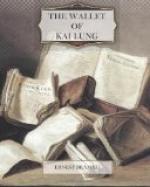Alas! it is well written, “The road to eminence lies through the cheap and exceedingly uninviting eating-houses.” In spite of this person’s great economy, and of his having begged his way from Kia-Lu to Peking in the guise of a pilgrim, journeying to burn incense in the sacred Temple of Truth near that city, when once within the latter place his taels melted away like the smile of a person of low class when he discovers that the mandarin’s stern words were not intended as a jest. Moreover, he found that the story-makers of Peking, receiving higher rewards than those at Kia-Lu, considered themselves bound to introduce living characters into all their tales, and in consequence the very ornamental drawings of birds and flowers which he had entwined into a legend entitled “The Last Fight of the Heaven-sent Tcheng”—a story which had been entrusted to him for illustration as a test of his skill—was returned to him with a communication in which the writer revealed his real meaning by stating contrary facts. It therefore became necessary that he should become competent in the art of drawing figures without delay, and with this object he called at the picture-room of Tieng Lin, a person whose experience was so great that he could, without discomfort to himself, draw men and women of all classes, both good and bad. When the person who is setting forth this narrative revealed to Tieng Lin the utmost amount of money he could afford to give for instruction in the art of drawing living figures, Tieng Lin’s face became as overcast as the sky immediately before the Great Rains, for in his ignorance of this incapable person’s poverty he had treated him with equality and courtesy, nor had he kept him waiting in the mean room on the plea that he was at that moment closeted with the Sacred Emperor. However, upon receiving an assurance that a rumour would be spread in which the number of taels should be multiplied by ten, and that the sum itself should be brought in advance, Tieng Lin promised to instruct this person in the art of drawing five characters, which, he said, would be sufficient to illustrate all stories except those by the most expensive and highly-rewarded story-tellers—men who have become so proficient that they not infrequently introduce a score or more of living persons into their tales without confusion.
After considerable deliberation, this unassuming person selected the following characters, judging them to be the most useful, and the most readily applicable to all phases and situations of life:
1. A bad person, wearing a long dark pigtail and smoking an opium pipe. His arms to be folded, and his clothes new and very expensive.
2. A woman of low class. One who removes dust and useless things from the rooms of the over-fastidious and of those who have long nails; she to be carrying her trade-signs.
3. A person from Pe-ling, endowed with qualities which cause the beholder to be amused. This character to be especially designed to go with the short sayings which remove gravity.




